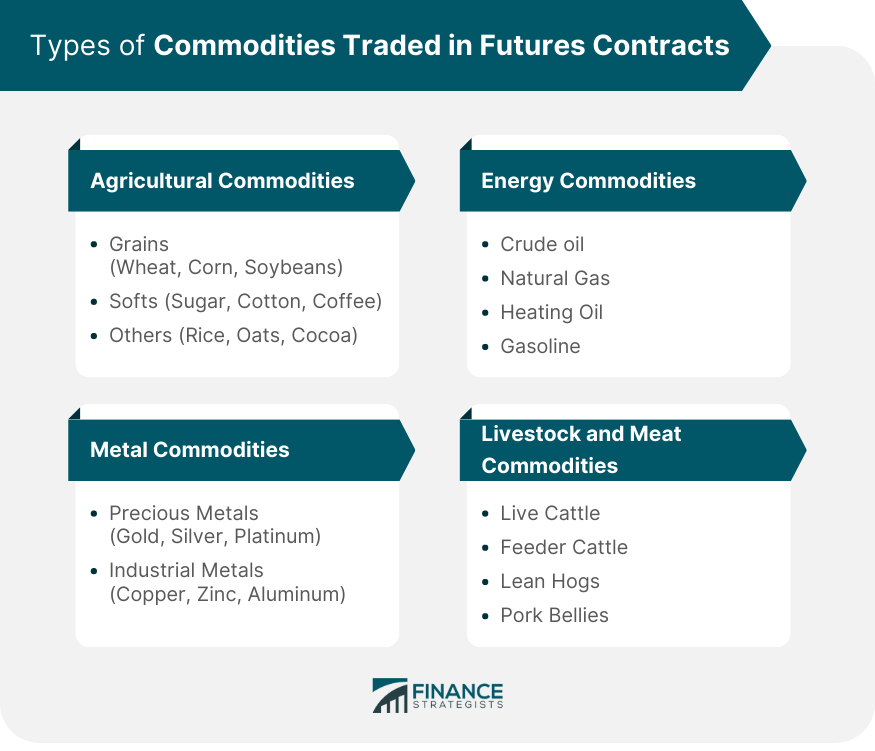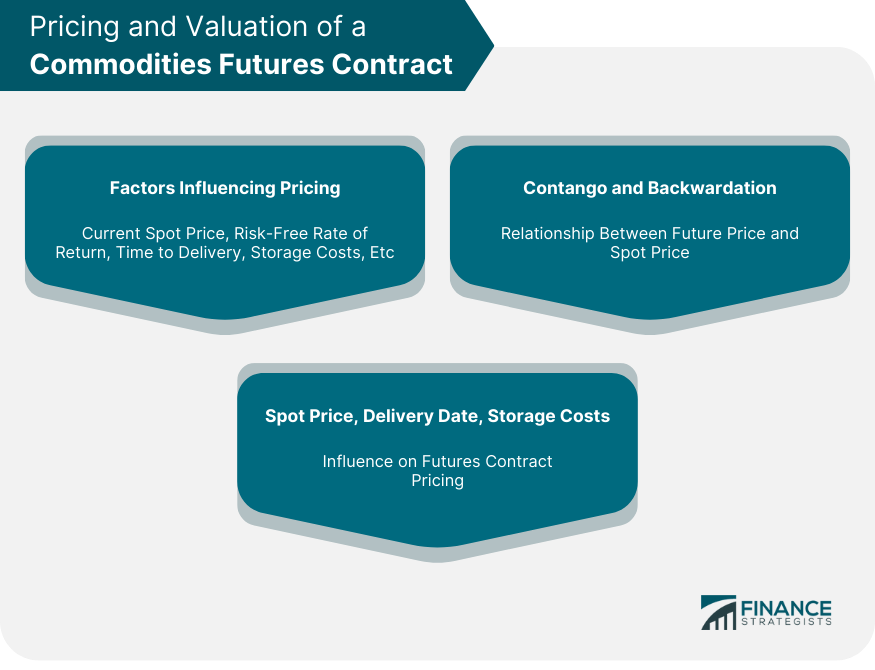A Commodities Futures Contract is a legally binding agreement between two parties to buy or sell a specific quantity of a commodity at a predetermined price, to be delivered at a future date. Commonly traded commodities include agricultural products, energy resources, metals, and livestock. Two primary participants in this market are hedgers, who seek to mitigate risk from price fluctuations, and speculators, aiming to profit from those very changes. The price of a futures contract is influenced by various factors including the current spot price, risk-free rate of return, storage costs, and the delivery date. While offering a mechanism for price risk management and the potential for significant returns, futures trading also involves substantial risk due to market volatility and leverage. As such, a comprehensive understanding of the commodities futures market is crucial for participants. Agricultural commodities form a significant portion of the futures market. They include crops and other plant-based commodities, often categorized as soft commodities due to their susceptibility to spoil or degrade. Commonly traded agricultural commodities include: Grains such as wheat, corn, and soybeans Softs like sugar, cotton, and coffee Other agricultural commodities, including rice, oats, and cocoa Energy commodities hold a significant position in the global economy and futures markets. They primarily include fossil fuels, which are essential for transportation, heating, and electricity generation. The most traded energy commodities are: Crude oil Natural gas Heating oil Gasoline Increasingly, futures contracts for alternative energy sources, such as ethanol or solar power, are emerging, reflecting the shift towards sustainable energy. Metals, both precious and industrial, are vital components of the commodities futures markets. Their utility in various industries, coupled with their innate value, makes them desirable commodities. Key metal commodities include: Precious metals such as gold, silver, and platinum Industrial metals like copper, zinc, and aluminum Livestock commodities represent an essential part of the futures markets. They consist of live animals and animal products. Key livestock and meat commodities are: Live cattle Feeder cattle Lean hogs Pork bellies A commodities futures contract is a legal agreement between two parties to buy or sell a specific quantity of a commodity at a predetermined price on a future delivery date. This financial instrument allows participants to secure a particular price and mitigate the risk of volatile market fluctuations. There are typically two main types of market participants: hedgers and speculators. Hedgers use futures contracts to protect themselves from price changes in commodities that are critical to their business operations, such as farmers or oil companies. Speculators, on the other hand, aim to profit from price changes. They have no intention of owning the underlying commodity; they're betting on the price direction. The Commodity Futures Trading Commission (CFTC) is the federal agency that regulates futures and options markets in the United States. Its primary role is to ensure the integrity, resilience, and vibrancy of the U.S. derivatives markets through sound regulation. Several elements affect the pricing of a futures contract. These include the current spot price of the commodity, the risk-free rate of return, the time to delivery, and storage costs, among others. Contango and backwardation are terms used to describe the relationship between spot prices and futures prices. Contango refers to a market condition where the future price of a commodity is higher than the current spot price. Backwardation, on the other hand, exists when the future price is lower than the spot price. Spot price, delivery date, and storage costs significantly influence the price of a futures contract. The spot price is the current market price at which a commodity can be bought or sold for immediate delivery. The delivery date is the predetermined date in the future when the commodity will be delivered, and storage costs represent the costs associated with storing the commodity until the delivery date. Market risks arise from factors that affect the entire market, such as inflation rates, exchange rates, political instability, and changes in economic indicators. These risks can lead to substantial losses if not properly managed. Operational risks involve the potential for loss resulting from inadequate or failed internal systems, procedures, or controls. These risks may include technological failures, human error, or events like fraud or natural disasters. Legal and regulatory risks pertain to the potential for loss due to non-compliance with laws or regulations, contractual obligations, or prescribed practices. Regulatory changes can impact the commodities futures market, affecting both the cost and the potential returns. Other risks associated with commodities futures trading include liquidity risks and counterparty risks. Liquidity risk refers to the difficulty of exiting a position, particularly in a volatile market. Counterparty risk involves the possibility that the other party involved in a futures contract may not meet their obligations. Hedging is a risk management strategy employed to offset potential losses that may be incurred by price fluctuations. Commodities futures contracts can help hedgers, such as farmers or manufacturers, protect themselves against adverse price movements. Speculators are market participants who attempt to profit from buying low and selling high. While speculators often get a bad reputation for their perceived role in driving market volatility, they provide valuable liquidity to the market, making it easier for other participants to enter and exit positions. Unlike spot trading, where commodities are bought and sold for immediate delivery, futures contracts involve agreeing on a price now for delivery at a future date. This characteristic provides an additional tool for managing price risk. While both futures and options are derivatives, they have crucial differences. An option gives the holder the right but not the obligation to buy or sell an asset at a predetermined price, while a futures contract obligates both parties to complete the transaction. Futures contracts is similar to forward contracts. However, futures are traded on an exchange, making them standardized contracts with clearer terms and conditions. Moreover, futures contracts have a daily settlement process which reduces credit risk. Technology has significantly impacted commodities futures trading. High-frequency trading, algorithmic trading, and the use of artificial intelligence have all become prevalent. These advancements have increased market efficiency but also brought new challenges. New commodities, such as carbon emissions and other environmental commodities, are now being traded on futures markets. Furthermore, the growth of emerging markets has seen the development of new futures exchanges around the world, broadening the global scope of commodities trading. The global trend toward increasing market transparency and regulation is likely to continue influencing the commodities futures market. Furthermore, geopolitical tensions, climate change, and technological developments will also shape the future of commodity futures. Commodities futures contracts are integral components of the global trading system, providing a platform for both risk mitigation and speculative trading. Traded commodities are diverse, ranging from agricultural goods, energy resources, and metals, to livestock. Market participants, primarily hedgers, and speculators, contribute to a dynamic and regulated trading environment. The pricing of these contracts is complex, influenced by multiple factors such as spot prices, risk-free rate of return, and storage costs. While these contracts offer potential for significant returns and risk management, they carry considerable risks, including market, operational, and legal risks. Understanding the distinctive characteristics of futures contracts in comparison to other financial instruments like spot trading, options, and forward contracts is essential. As technology continues to revolutionize trading and new commodities emerge, the commodities futures market is poised for continuous evolution and expansion.Commodities Futures Contract Overview
Types of Commodities Traded in Futures Contracts
Agricultural Commodities
Energy Commodities
Metal Commodities
Livestock and Meat Commodities

Commodities Futures Contract Mechanics
How a Commodities Futures Contract Works
Participants in the Commodities Futures Contract Market
Role of the Commodity Futures Trading Commission (CFTC)
Pricing and Valuation of a Commodities Futures Contract
Factors Influencing the Pricing
Explanation of Contango and Backwardation

Role of Spot Price, Delivery Date, and Storage Costs
Risks Associated With Commodities Futures Contract
Market Risks
Operational Risks
Legal and Regulatory Risks
Other Risks
Commodities Futures Contracts for Hedging and Speculation
Role of a Commodities Futures Contract in Hedging
Commodities Futures Contract and Speculation
Commodities Futures Contract vs Other Financial Instruments
Spot Trading
Options
Forward Contracts
Recent Developments in Commodities Futures Contract
Impact of Technology on Commodities Futures Contract Trading
Emergence of New Commodities and Futures Markets
Global Trends and Future Outlook for Commodities Futures Contract
Conclusion
Commodities Futures Contract FAQs
A Commodities Futures Contract is a legal agreement between two parties to buy or sell a specific quantity of a commodity at a predetermined price, to be delivered at a future date. This tool allows market participants to hedge against price volatility or speculate for potential profits.
Various commodities are traded in futures contracts, including agricultural products like wheat, corn, and soybeans; energy commodities such as crude oil and natural gas; metal commodities like gold, copper, and silver; and livestock commodities including live cattle and lean hogs.
The CFTC is the federal agency responsible for regulating futures and options markets in the United States. Its primary purpose is to ensure the integrity, resilience, and vibrancy of the U.S. derivatives markets through sound regulation.
Trading in commodities futures contracts comes with various risks, including market risks (factors affecting the entire market), operational risks (failures in internal systems or procedures), legal and regulatory risks (potential losses due to non-compliance), as well as liquidity and counterparty risks.
Unlike spot trading, futures contracts involve agreeing on a price now for future delivery, helping manage price risk. They are similar to options, but unlike options, futures contracts obligate both parties to complete the transaction. Compared to forward contracts, futures are standardized and traded on an exchange with daily settlement, reducing credit risk.
True Tamplin is a published author, public speaker, CEO of UpDigital, and founder of Finance Strategists.
True is a Certified Educator in Personal Finance (CEPF®), author of The Handy Financial Ratios Guide, a member of the Society for Advancing Business Editing and Writing, contributes to his financial education site, Finance Strategists, and has spoken to various financial communities such as the CFA Institute, as well as university students like his Alma mater, Biola University, where he received a bachelor of science in business and data analytics.
To learn more about True, visit his personal website or view his author profiles on Amazon, Nasdaq and Forbes.











